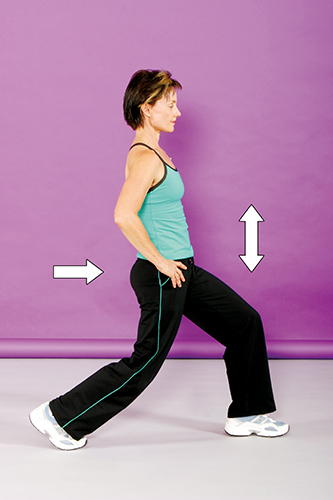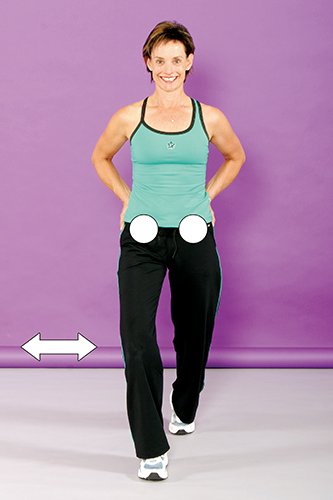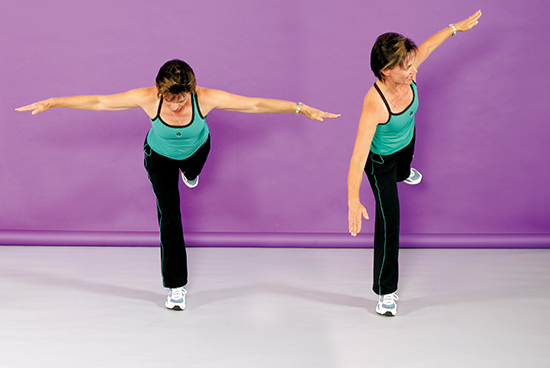Better Balance for Better Riding – Part Two
By Lisa Champion MSc (exercise science)
In Part I last month, we took a good look at the movement skill of balance and the relationship between improving your balance and improving your riding. This month, we’ll take a closer look at the specific muscles in the body that need to be strengthened to improve balance and control both on and off the horse.
Performing the balance test from last month’s article will give you a good idea if your balance skills could be improved. If they could (and there would be the odd athlete among you who doesn’t) you’ll be surprised to learn that good balance has a lot to do with your butt! You’ll need to work on strengthening and learning to control the muscles in your bottom better. You’ll know the exercises are working when you improve your balance on the ground – and you’ll be amazed at how much these simple exercises will help with your balance and symmetry in the saddle.
Using your buttocks better
The buttocks play a vital role in controlling not only our hips, but also help coordinate our trunk and leg movement. Most of us think of our buttocks as being two big muscles that sit at the top of our legs. In fact the buttocks are made up of a series of muscles which are arranged in layers.
Each muscle layer plays a specific role in controlling hip movement and consequently influences the alignment and stability of the trunk – which influences how well you can balance. If the muscles of the buttocks are weak, the hip area can become unstable. So, strengthening the buttocks contributes to better balance.
The gluteus maximus
The gluteus maximus is the most superficial muscle of the buttock complex. Because many of us spend more time sitting on our gluteus maximus than using it, it often gets very weak and loses tone. You will know it is not working well by just feeling it. If poking your bottom feels more like pushing into a sponge than a firm melon, then chances are you are not activating this muscle as well as you could.
Off the horse, a strong gluteus maximus will not only help with your balance, but with walking – we often call it the retrorocket for your trunk. In the saddle, a strong gluteus maximus gives you the power you need to drive your horse forward, to maintain a good connection, to keep your horse active in the collected work and to be balanced and centred. The best exercise to improve your gluteus maximus is the lunge – but if you’ve done lunges before at the gym, be warned, this is a lunge with a difference (all the focus is on the back leg – not the front). Make sure to do the hip and buttock stretches from last month’s article before you do these exercises – the stretches will take the hand brake off your muscles and make them work much better.
Photo 1
The Lunge
For perfect set-up, start in a kneeling 90°/90° position, left leg forward. Stand up, then move the back leg in slightly – rolling onto the toe of the back foot which should be at a 45° angle. (see Photo 1)
Balance your weight evenly over both feet. Maintaining perfect alignment, slowly lower, bending both knees, then fire your right glute (the one on the back leg) as you raise back up.
Think of moving your pubic bone towards your nose and keep the right glute firing as you lower up and down very slowly. Repeat 8-10 times before switching to the other side.
The gluteus medius and minimus…the deep buttock muscles
These muscles make up the deeper layers of the gluteal complex. They are postural muscles and so are involved in control, rather than strength. If you put your finger into the side of your buttock and press quite firmly you will feel a very tender spot. This is approximately the position of these muscles. Because of their location and function they control both the “side to side” movement of your pelvis and the rotation of your leg from the hip. Their role is to control the alignment of the leg relative to the pelvis. In walking they activate to keep your pelvis level and stable as you step onto your leg.
In riding their role is to control the alignment of the leg and allow you to put the whole leg on from the hip. They will also influence the alignment of your toes.
When they are working optimally the rider can keep themselves grounded in the saddle, making subtle changes of pressure in their seat, using these muscles to control the horse’s position. You’ll be able to put your leg aids on more effectively from the hip, and your ability to influence the horse while maintaining your hip and trunk alignment will be greatly improved.
When they are weak, the rider will compensate by using other global muscles in the leg, knee and foot, to control the leg alignment. It’s like trying to ride from the feet up instead of the seat down.
Why do they get weak?
Sloppy walking, standing slumped onto one leg all the time, sitting with your legs crossed…these are all postural habits off the horse that contribute to weakening these deep muscles. Weakness drops the hip sideways which influences how well you can balance.
Try this deep hip controller exercise to strengthen and learn how to control your deep glute muscles. As they are postural muscles, you will find that linking the exercise with core activation through your breathing pattern will help you to get them firing.
The deep hip controller exercise
Place your right foot in front of your left and your hands on your buttocks with your right fingertips pushing into the soft, tender spot on the side of your buttock. If possible, use a mirror to make sure that your hip, knee and toe are aligned. Take a deep breath in.
Exhale, think of drawing up your pelvic floor muscles as you slowly move your leg outwards. Use your right fingertips to feel for muscle activation in your glute.
Breathe in as the leg moves inward, out as the leg moves out.
The outward rotation movement is initiated in the deep buttock – not by moving the knee. Repeat 10 to 15 times before switching to the other leg.
Once you have a better idea of using your gluteal muscles, it’s time to progress to the more advanced balancing exercises. Remember, these are progressions from last month’s exercises, so be sure to perfect the easier versions before attempting these.
Photo 2
Balance 201
This first exercise, the Airplane, is really a series of balance work.
The airplane
Stand with your feet on train tracks, your hips even and your shoulders relaxed.
Begin by raising your left leg into a simple standing leg balance. (Photo 3)
Keeping your left knee slightly bent, hold this position for several breaths.
Breathe in and as you exhale, slowly bring your upper body forward as your leg moves back until you have perfect alignment. (Photo 4)
Finally, open your arms out into the Airplane position (Photo 5) and hold for five breaths.
For added challenge, perform four small squats on your right leg before you return to the starting position. Repeat on the other side.
Photo 3, 4, and 5
The banking airplane
This last exercise increases the challenge further, and also works your deep glute muscles.
Start as per the Airplane (Photo 6)
Once you have held the Airplane balance for several breaths, ‘bank the airplane’ to the left (Photo 7). Hold for a few breaths, return to the straight position.
Ensure that you are using your glute muscles in the left leg to rotate the body and that you are maintaining perfect alignment as you bank and straighten.
Bank, straighten, bank, straighten 3-5 times before switching to the other side.
Photo 6 and 7
Brain connection
In addition to needing good muscle activation, you’ll need to use your brain as you are performing these balancing exercises. Exercise (and this includes riding) without a brain connection will never give you optimal performance. Take responsibility for breathing well, feeling the right muscles work, using perfect technique and concentrating. Remember that good balance is about a soft integrity in the body, not about rigidness.
The combination of working on your gluteal muscles and practicing these balance skills is sure to improve the way your body moves, both on and off the horse!
This article was first published in THM November 2005.




